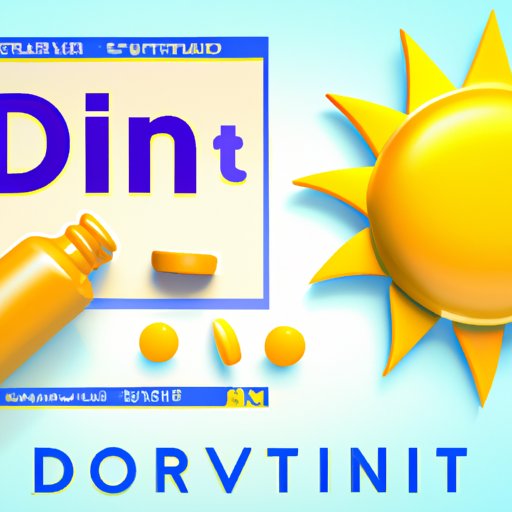
Introduction
Vitamin D is an essential vitamin that plays a crucial role in maintaining good health. It is produced in the body through sunlight exposure. However, there is a growing concern about how much skin needs to be exposed for effective vitamin D absorption without increasing the risk of skin cancer. In this article, we will explore how much skin needs to be exposed for effective vitamin D absorption, the risks and benefits of sunlight exposure, and alternative sources of vitamin D for people with limited sunlight exposure.
The Importance of Vitamin D and its Role in Maintaining Good Health
Vitamin D plays a crucial role in maintaining good health. It helps the body absorb calcium and phosphorus, essential minerals for healthy bones and teeth. Vitamin D also plays a role in muscle function, immune system regulation, and overall well-being.
Sunlight Exposure and Vitamin D: Finding the Right Balance
The body produces vitamin D through sunlight exposure. However, excessive sun exposure can damage the skin and increase the risk of skin cancer. It is important to find the right balance between sun exposure and vitamin D production. The amount of sunlight exposure needed to produce vitamin D depends on various factors, such as skin type, location, and time of day.
How Much Skin Needs to be Exposed for Effective Vitamin D Absorption?
To produce vitamin D, the skin needs to be exposed to UVB radiation. Experts recommend exposing the arms, legs, and face to sunlight for 10-15 minutes a day, two to three times a week. However, the amount of sunlight exposure needed varies depending on the individual’s skin type and location. People with lighter skin can produce vitamin D more quickly than those with darker skin.
The Risks and Benefits of Overexposure to Sunlight
Overexposure to sunlight can lead to various health problems, including skin cancer, premature aging, and eye damage. However, sunlight exposure also offers several benefits, including vitamin D production, mood improvement, and better sleep. It is important to find the right balance between sun exposure and health risks.
Alternative Sources of Vitamin D for People with Limited Sunlight Exposure
People who have limited sunlight exposure can get vitamin D from alternative sources, such as foods, supplements, and artificial UV lighting. Vitamin D-rich foods include fatty fish, egg yolks, and fortified milk. Vitamin D supplements are also widely available. However, it is important to take the recommended dose and consult a healthcare professional before taking any supplements. Artificial UV lighting, such as UV lamps, can also help produce vitamin D. However, excessive use of UV lamps can damage the skin and increase the risk of skin cancer.
Seasonal Variations in Vitamin D Absorption and Health Implications
The amount of sunlight exposure needed to produce vitamin D varies depending on the season. In some regions, the angle of the sun is too low during the winter months, making it difficult to produce vitamin D through sunlight exposure alone. During these times, it is important to supplement with alternative sources of vitamin D to maintain healthy levels.
Vitamin D Deficiency: Causes, Symptoms, and Prevention Strategies
Vitamin D deficiency can lead to several health problems, including rickets, osteoporosis, and a higher risk of certain types of cancer. Causes of vitamin D deficiency include limited sunlight exposure, dietary factors, and medical conditions. Symptoms of vitamin D deficiency include bone pain, muscle weakness, fatigue, and mood changes. Prevention strategies for vitamin D deficiency include getting adequate sunlight exposure, consuming vitamin D-rich foods, and taking supplements when necessary.
Conclusion
To maintain good health, it is important to find the right balance between sunlight exposure and health risks. Several factors, such as skin type, location, and time of day, influence how much sunlight exposure is needed to produce vitamin D. If you have limited sunlight exposure, it is essential to supplement with alternative sources of vitamin D, such as foods, supplements, and artificial UV lighting. With proper sun exposure practices and awareness, you can maintain healthy vitamin D levels and enjoy the benefits of sunlight exposure.





